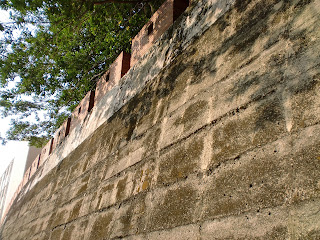以前、台南の城壁の事をこのブログで書いた。勿論、このブログのファンの皆さんは私の書いた事を一言除かずに暗記したと思う(恐らく毎日寝る前にブログの内容を念ずる人も居るかもしれない。)でも、もしかしてちょっと忘れた人(なんで忘れたと!?駄目ばい!)も居るので、復習しよう。
台南は清朝時代に都市の周りに城壁が建てられた。日本時代には、町の改造のため、城壁が殆ど取り除かれたけど、大南門などの一部が現在も残っている。私は以前、門だけじゃなくて、城壁自体も少し残っていると聞いた。残っている部分は国立台南大学の辺りに有るから、簡単に自転車で成功大学から見に行く事が出来る。
私は本当にこういう史跡が大好きだ。入場費などは無い、というか、小さな看板、石碑と史跡自体以外は何も無い。そこで生活している人の中に、史跡だと気付いていない人も居るに間違いない。下の写真をご覧下さい。
I have written previously about the Tainan city walls. They were put up around the city in the Qing period, but they were mostly torn down during the Japanese period as a result of Japanese plans to modernize the city's layout. There are a couple of gates left, but there is also at least one section of wall left as well. I heard about it a while back, and I had been meaning to visit it when I had some free time and a nice sunny day. I had both last Sunday, so I headed out on my bicycle to the remaining section of wall that is near the University of Tainan campus. It's only about a 15 minute ride away from Cheng Kung's campus if you don't get lost. Of course, I got lost. But I did find it eventually.
This is my favorite kind of historic spot. Not only is there no entrance fee to see it, but it's so low key that if you don't notice the plaque, you might never even know that it was something historic. I'm willing to bet money that there are people who live in the neighborhood who have never realized that the wall they pass by on their scooter every day dates back to the Qing Period.
普通に清朝時代の城壁の前にゴミ収集の場所が有るみたい。おい、おい!汗と血を流して城壁を作ったご先祖は泣いているよ!そこにゴミ置くのか!?Exhibit A for how much a part of the neighborhood the wall is: This space here appears to be a garbage collection site. (Either that or people are just illegally leaving garbage there.)
これで史跡だと分かる。
This is how you know you are looking at history.
城壁についての説明が書いて有る。「1788年に二年間かけて建てられた。その後、(西暦が無いので、いつか分からない)木材から粘土(?)と石の城壁に代えられた。その後の日本時代に、廃墟と成って、ちょっと崩れてきて、雑草が生えて来た(と書いていると思う)。長さは64メートル、高さは約5メートル。最近少しは修理された。(そして訳分からん事沢山書いている。)」
A plaque! I love plaques! This one says: "The walls were constructed in 1788 and took two years to complete. They were originally wood and later converted to mud/mortar(?) and stone. (There's only an imperial date, no western date, and I don't feel like looking up the Qing Imperial calendar, so I don't know when the walls were converted.) Afterwards, during the Japanese period, the walls fell into disrepair and weeds grew from them. (Something like that.) The wall is 64 meters long (so, like 70 yards maybe) and 5 meters high (a little over 5 yards). Recently the wall has been fixed up a bit. (Then there's a bunch of stuff written that I don't really understand.)
格好いいさぁ!
以上で、台南市の城壁の残っている一部だ。こういうのが台南に沢山有るから、台南は面白いばい!
Imagine driving by this every day on the way to work. That's Tainan for you. It's got lots of random historic stuff scattered around the city, and some of it, like this wall, is very much a part of the neighborhood fabric.










No comments:
Post a Comment